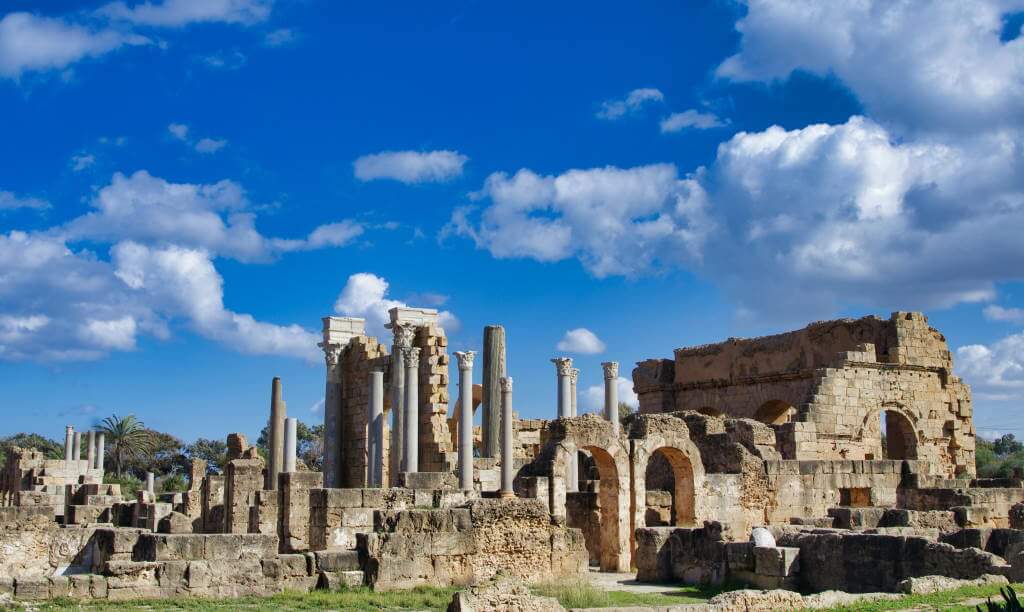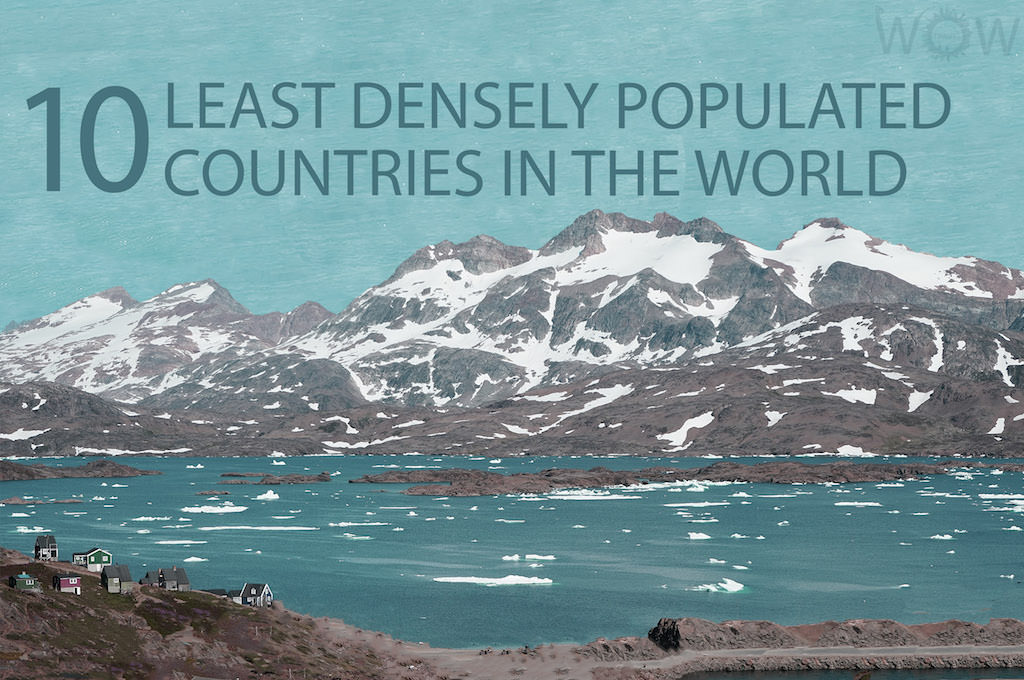Do you long for peace and solitude on your travels? If so, then you should consider taking your next break in one of these 10 least populated countries in the world. Currently, there are 195 countries on Earth. And, of course, not all of them are as densely populated as New York, where more than 10,000 people are sharing the same space per square km². Some of them are smaller and surprisingly deserted. Today, we’re going to show you some of the countries with the lowest population. Some of them may shock you, and you may never even hear of some of them. Going to one of these countries may be a good call if you want to have a one-of-a-kind trip. Measured by the number of human inhabitants per square km², here’s our list.
Table of contents
Libya
10
What’s the least populated country in North Africa? It’s Libya! There are several reasons why not many people live here. One of the continent’s most beautiful places, Libya doesn’t have enough water to support its agriculture. Hence, it’s difficult for the country to accommodate a high population.
Yes, Libya is huge. However, a great majority of the country is desert, which is uninhabitable. Thus, most people live in coastal cities. However, this doesn’t mean you shouldn’t visit Libya. For instance, Tripoli, a city in Tarabulus, has plenty of amazing attractions like Madina Tripoli and Leptis Magna. Trip.com even encourages you to visit this city.
Population: 7,122,157
Area: 1,759,540 km² / 679,362 mi²
Population Density: 4 (people/km²)

Suriname
9
Suriname is a tiny country and a former Dutch Colony with a very interesting history. It was first colonized by the English, then by Dutch, and was influenced by different cultures. So, it’s only normal for Suriname to have unique cultures. But apart from that, it’s also known for its natural resources, such as timber and gold.
So, why is Suriname part of the 10 least populated countries in the world? That’s because most parts of the country are forests. As you can imagine, living in those areas must be hard. Not to mention, there are many wild creatures and snakes. And because of the country’s humidity, it can get extremely hot as well. But if you want to challenge yourself and witness Suriname with your own eyes, you should also check out the top things to do in Suriname.
Population: 600,740
Area: 163,820 km² / 63,251 mi²
Population Density: 4 (people/km²)

French Guiana
8
Found between Suriname and Brazil, French Guiana is the second-biggest region of France. But big doesn’t mean it’s densely populated, right? French Guiana has only around 4 people per km². Technically, it’s still part of France as well as the European Union. After all, French Guiana’s currency is Euro. However, it’s also independent of its colonizer.
So, what can you expect from French Guiana? As one of the hidden gems on this list, it’s home to a plethora of forests, rivers, and wildlife. For those who love the outdoors and nature, French Guiana is heaven. And since it only has around 10,000 visitors per year, you don’t have to go through a war to find a nice place to stay.
Population: 319,482
Area: 83,534 km² / 32,253 mi²
Population Density: 4 (people/km²)

Iceland
7
Iceland is a volcanic island located in the North Atlantic Ocean, 300 km (186 mi) east of Greenland and 900 km west of Norway. According to Guide to Iceland, Glaciers cover over 10% of Iceland’s territory, making it one of the coldest countries in the world. With only 3.64 people per km², it’s more sparsely populated compared to other European countries. Not to mention, there are plenty of active volcanoes in the country.
Apart from the glaciers and volcanoes, the climate also impacts Iceland’s population. The temperature can be cruelly cold, especially during winter. So, it’s definitely not the sunniest travel destination. Most of the country’s inhabitants live in the coastal areas because they are the most fertile regions on the island.
Population: 347,186
Area: 102,800 km² / 39,691 mi²
Population Density: 3.64 (people/km²)

Australia
6
Australia is located in the Southern Hemisphere near Indonesia, New Zealand, Papua New Guinea, and Vanuatu. It is an island nation that makes up the Australian continent as well as the island of Tasmania and some other small islands. Though it’s the world’s sixth biggest nation when it comes to physical area, did you know that it’s also the smallest of the world’s continents? And with just 3.42 people per km², Australia made it into our list of least-populated countries.
Apart from that, Australia has a high amount of outback. Most of Australia’s interior is desert, and living there is extremely difficult. However, major cities like Sydney and Melbourne are extremely crowded and comparable to bigger Western countries. Also, did you know that Melbourne is one of the safest cities in the world? There are so many exciting things to do in Melbourne, and once you’re ready to call it a day, the best hotels in Melbourne are ready to accommodate you.
Population: 26,294,947
Area: 7,692,024 km² / 2,969,907 mi²
Population Density: 3.42 (people/km²)

Namibia
5
What we have here is a country in Southern Africa with the lowest population number. Namibia sits on the Atlantic Ocean and borders similarly sparsely populated Botswana to the East. With a population density of 3 people per km², it’s a really quiet country. The most obvious and main reason why the country is so sparsely populated is that it’s mostly desert. With a limited amount of fresh water, it’s extremely challenging for Namibia to support a huge number of people.
Though it could use some rain, Namibia is nothing short of beautiful. Every morning people in Namibia can witness the stunning sunrise. Also, according to Signature Safaris, there are around 3,000 free-roaming cheetahs in Namibia. Have fun spotting one! Additionally, you can also sleep under the beautiful stars scattered in the night sky. Those who love photography and gazing will surely fancy Namibia.
Population: 2,664,357
Area: 824,292 km² / 318,260 mi²
Population Density: 3 (people/km²)

Western Sahara
4
As you can guess, Western Sahara is a country that’s mostly covered by desert. There’s almost no arable land in this country. For as long as people can remember, until the 20th century, Western Sahara is occupied by the Sahrawi. But since Morocco’s attempted annexation, the country’s population has increased.
Today, the majority of Western Sahara is populated by those living in urban areas. The kasbahs and sand dunes scattered around the country are some of the things that attract visitors. But with dry weather all year long, you’ll want to bring your best moisturizer with you and keep yourself hydrated.
Population: 636,795
Area: 266,000 km² / 103,000 mi²
Population Density: 3 (people/km²)

Mongolia
3
Mongolia, the world’s second-largest landlocked country, is located in the landlocked plateau of Central Asia between China and Russian Siberia. Situated on mountains and plateaus, it is one of the world’s highest countries, with an elevation averaging 1,580 meters (5,180 ft). However, this also explains why it’s named one of the 10 least populated countries in the world.
Because of the country’s geographic condition and extreme climates, not many people live here. In Mongolia, the winters are super long, and the temperatures are extremely cold. It’s definitely one of the coldest cities on Earth. But this doesn’t mean it’s not worth visiting. Mongolians are welcoming and friendly. Though it may not be the most vibrant, the locals aren’t afraid of showing off their unique cultures to the world and visitors.
Population: 3,419,764
Area: 1,600,000 km² / 617,763 mi²
Population Density: 2.20 (people/km²)


Falkland Islands
2
Up next on our list of least populated countries is the Falkland Islands. The Falklands are a group of islands located in the southern Atlantic Ocean, about 460 km (285 mi) east of the South American coast. It comprises over 700 different islands. Knowing this, you may think the Falkland Islands archipelago is densely populated. However, it’s far from the truth. Its population density is only 0.31 people/km².
The Falkland Islands belong to the United Kingdom but govern themselves. This place is so small that only a few hotels in the Falkland Islands exist. In addition to that, the Falkland Islands is one of the best travel destinations for wildlife enthusiasts. That’s because it’s home to countless penguins, sea lions, elephant seals, and others. In fact, bird-watching is one of the top things to do in the Falkland Islands.
Population: 3,787
Area: 12,173 km² / 4,700 mi²
Population Density: 0.31 (people/km²)

Greenland
1
Greenland is a dependency of the Danish Kingdom, geographically present amid the Arctic & Atlantic Oceans following the eastern sides of the Canadian Arctic Archipelago. The state is independent & maintains its sovereignty within Denmark. Despite being the largest island in the world and one of the biggest countries on Earth, it still tops our list.
This vast land, which has been inhabited for around 4,500 years, has only around 0.14 people per km². The majority of the people living in Greenland are Kalaallit and more than 80% stay on the southwest shore. In addition to that, most parts of the country are covered by a glacier. But with beautiful mountainous shorelines, long summer days, and jewel-blue fjords, we think Greenland is worth visiting. And if you plan to check out this city, you should read our list of the top things to do in Greenland.
Population: 56,889
Area: 2,166,086 km² / 836,330 mi²
Population Density: 0.14 (people/km²)



What’s the least populated country in the world?
It’s none other than Greenland, with only 0.14 people/km². That’s because most parts of the country are covered in ice, making them uninhabitable.
Why is Australia underpopulated?
As we mentioned earlier, the major cities of Australia are crowded. However, the majority of the country’s inner parts are desert and semi-arid, making it hard to live there.
What are the causes of the sparse population?
There are many reasons why a country is sparsely populated, but the major ones are usually the unfriendly climates and uneven terrain. Countries in semi-arid and hilly regions are hard to occupy, and extreme climatic conditions also prevent people from living there.
